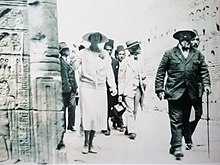Jean Capart | |
|---|---|
 | |
| Born | February 21, 1877 |
| Died | June 16, 1947 (aged 70) |
| Nationality | Belgian |
| Occupation | Egyptologist |
Jean Capart (February 21, 1877 – June 16, 1947) was a Belgian Egyptologist, who is often considered the "Father of Belgian Egyptology."[1]
Jean Capart | |
|---|---|
 | |
| Born | February 21, 1877 |
| Died | June 16, 1947 (aged 70) |
| Nationality | Belgian |
| Occupation | Egyptologist |
Jean Capart (February 21, 1877 – June 16, 1947) was a Belgian Egyptologist, who is often considered the "Father of Belgian Egyptology."[1]
Capart was born to Alphonse Capart, an otolaryngologist, and Alida Carbonelle in Brussels on 21 February 1877.[1][2][3] He studied Egyptology under Karl Alfred Wiedemann at Bonn University.[2]
In 1900, he was appointed to be assistant conservator of the Egyptian collection at Musées royaux du Cinquantenaire, Brussels, prior to that he had been a free collaborator with the museum for two years.[3] He held this position until 1911 when he was appointed Curator.[3] In 1925, he becomes Chief Curator and Director, and from 1942 until his death, he held the title Honorary Chief Curator.[2][3]
Early in his tenure at the Musées Royaux du Cinquantenaire, he convinced the Belgian government to purchase a subscription to the Egypt Exploration Fund, now the Egypt Exploration Society, and he became the local secretary of the EEF for Belgium.[4] He would travel yearly to London to meet with William Flinders Petrie to negotiate what objects would be sent to Belgium from their subscription.[4] From 1926 to 1927, he edited the Bibliography of Ancient Egypt in the Journal of Egyptian Archaeology, the journal hosted by the EEF.[4]
He also bought objects for the Musées Royaux du Cinquantenaire from various collection sales including those of Gayet (1901), Amélineau (1904), Somzée (1904), Philip (1905), Hilton Price (1911), Amherst (1921) and MacGregor (1922).[4]

Capart also maintained a relationship with American Egyptology. From 1932 to 1938, he was a part-time Honorary Curator of Egyptology at the Brooklyn Museum, and then Honorary Advisory Curator from 1938 until his death.[2][5]
In 1902, he is made the first Belgian chair of Egyptology at the University of Liege.[6] In 1910, the Institut Supérieur d'Histoire de l’Art et d'Archéologie was established and Capart was appointed as a professor.[4] In 1929, he became an honorary professor, entrusting his teaching responsibilities to his student, Baudouin van de Walle.[7]

He was director of the El-Kab excavations from 1927 to 1929 and then 1945.[1]

On February 18, 1923, he guided Queen Elisabeth of Belgium through the Tomb of Tutankhamun.[1][2] Following this trip, Capart founded The Association Égyptologique Reine Elisabeth, which publishes the journal Chronique d' Égypte.[8] He also guided the Queen on later trips in Egypt, which included visiting the Temple of Horus at Edfu in 1930.
In 2015, Fonds Jean Capart, was set up in his honour "to promote the historical heritage of the Belgian Egyptologist Jean Capart with a view to nurturing both the historical and scientific aspects of Egyptology in Belgium."[9]